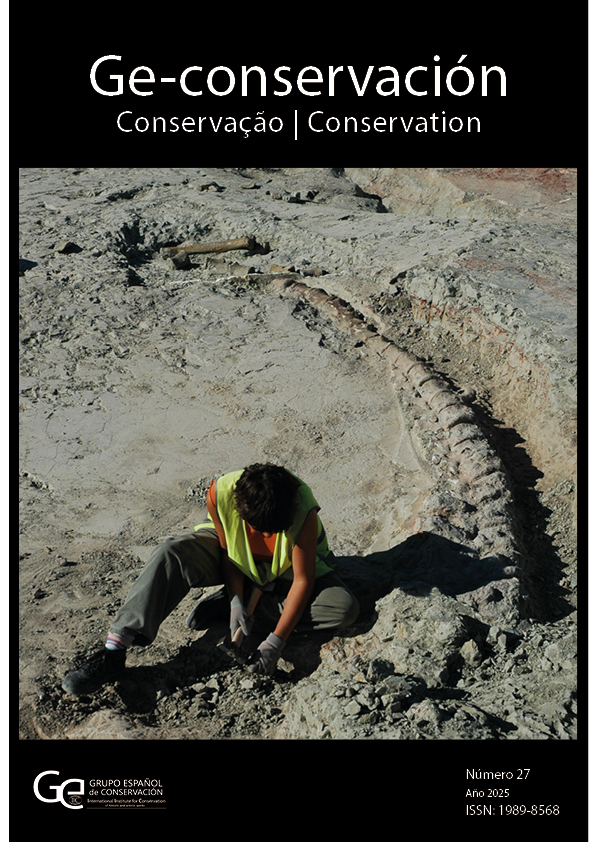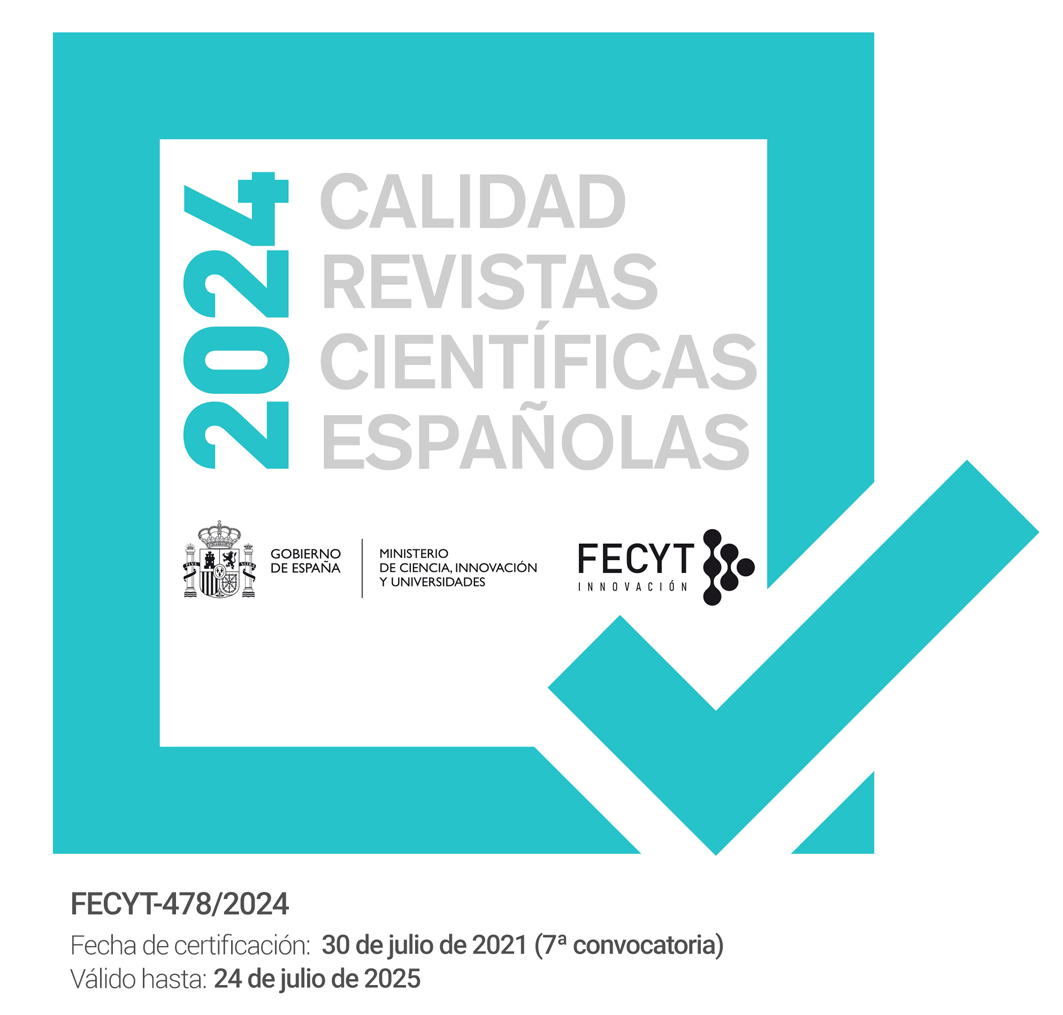Characterization of threats arising from climate change and identification of impacts on archaeological sites
Abstract
In initial stages, the conservation of archaeological sites had a reactive nature, in which interventions were aimed at alleviating damage caused by different causes and returning them to their state closest to the original. Later, thanks to the incorporation of the discipline in preventive conservation, the interventions are preceded by an identification of the impacts produced and consist of measures that, proactively, aim to alleviate future deterioration. The threats derived from climate change represent a challenge in which, first of all, we have to anticipate the identification of the impacts with the help of projections; Secondly, it is necessary to study unknown vulnerabilities and finally, implement adaptive measures to face this new situation.
This article contemplates the first phase, with a review of the studies carried out that relate to the threats derived from climate change and the impacts identified on archaeological sites.
Downloads
References
ABAJO, B., NAVARRO D., GARCÍA G., ZORITA S., FELIU E., KLETT P., SÁNCHEZ M. Y HERAS F. (2023): Guía para la evaluación de riesgos asociados al cambio climático 2023. Ministerio de Transición Ecológica y Reto Demográfico. ISBN (online): 978-84-18508-95-0. https://adaptecca.es/sites/default/files/documentos/miteco_guia_evaluacion_riesgos_cambio_climatico_2023.pdf
ADAPTECCA(s.f.).https://escenarios.adaptecca.es/#&model=EURO-CORDEX-EQM.average&variable=tasmax&scenario=rcp85&temporalFilter=year&layers=AREAS&period=MEDIUM_FUTURE&anomaly=RAW_VALUE1 [consultado 05/08/2024]
AEMET (2023). Agencia Estatal de Meteorología. Ministerio para la Transición Ecológica y el Reto Demográfico. Informe del estado del clima en España 2023. https://www.aemet.es/es/conocermas/recursos_en_linea/publicaciones_y_estudios/publicaciones/detalles/informe_estado_clima.
AEMET. (s.f.). Agencia Estatal de Meteorología. Ministerio para la Transición Ecológica y el Reto Demográfico. www.aemet.es/es/eltiempo/observaciones/ultimosdatos
AMBLAR, P., CASADO, M. J., PASTOR, A., RAMOS, P.Y RODRÍGUEZ, E. (2017). Guía de escenarios regionalizados de cambio climático sobre España a partir de los resultados del IPCC-AR5. Agencia Estatal de Meteorología. Ministerio de Agricultura, Pesca y Alimentación. https://doi.org/10.31978/014-17-010-8
BASCONCILLOS ARCE, J. (2024). Riesgos Natuales. Identificación y Análisis online. Unidad Didáctica 1. Introducción a los Riesgos Naturales. D.G. de Protección Civil y Emergencias. Ministerio de Interior. http://creativecommons.org/licenses/by/4.0/
BOE (2011). Nº 173, 20 de julio. Instrumento de Ratificación del Convenio Europeo para la protección del patrimonio arqueológico (revisado), hecho en La Valeta el 16 de enero de 1992. Convenio europeo para la protección del patrimonio arqueológico. Artículo 1. https://www.boe.es/buscar/doc.php?id=BOE-A-2011-12501. [consulta 27/01/2024]
CID, A., MENÉNDEZ M., CASTANELO S., ABASCAL A, MÉNDEZ F. Y MEDINA R., (2016). “Long‑term changes in the frequency, intensity and duration of extreme storm surge events in southern Europe”, Clim Dyn 46:1503–1516 https://doi.org/10.1007/s00382-015-2659-1
Copernicus atlasC3S. (s.f.). https://atlas.climate.copernicus.eu/atlas [consulta 06/08/2024]
Climate-ADAPT. (s.f.). https://climate-adapt.eea.europa.eu/en/about [consulta 20/12/2024].
CLIMATE CHANGE AND CULTURAL HERITAGE WORKING GROUP INTERNATIONAL (2019). The Future of our past. Engaging cultural heritage in climate action. Technical Report. International Council on Monuments and Sites - ICOMOS, ICOMOS Paris, 62. https://openarchive.icomos.org/id/eprint/2459/%2026/03/2023
DALY C. (2011). “Climate Change and the Conservation of Archaeological Sites: A Review of Impacts Theory, Conservation and mgmt of arch. sites, 13(4): 293–310. https://doi.org/10.1179/175355212X13315728646058
DALY C. (2014). “A Framework for Assessing the Vulnerability of Archaeological Sites to Climate Change: Theory, Development, and Application”. Conservation and mgmt of arch. sites, 16(3): 268–282. https://doi.org/10.1179/1350503315Z.00000000086
DÍAZ P., OJEDA, J. P. PÉREZ J. P. Y DISEÑO J. (2012). “Diseño y funcionalidades de un Visor Web para la participación pública en los procesos de planificación y gestión costera “. GEOTEMAS 15: 105
EEA (2023). European Climate Risk Assessment. Agencia Medioambiental Europea. https://www.eea.europea.eu/publications/european-climate-risk-assessment.
ETCCDI (s.f.). Equipo de Expertos en Detección e Índices de Cambio Climático. https://www.wcrp-climate.org/etccdi [consultado el 17/07/2024]
GARCÍA GONZÁLEZ, M. B., JORDANO, P. (2020). Global change impacts. Consejo Superior de Investigaciones Científicas (España). http://doi.org/10.20350/DIGITALCSIC/12654
GARROTE L., SORDO-WARD A. EIGLESIAS A. (2020). Eventos hidrológicos y modelización. Fundación Canal II. https://adaptecca.es/sites/default/files/documentos/2020_eventos-hidrologicos-extremos-y-cambio-climatico_fundacioncanal.pdf
GREENPEACE (2024). Crisis a toda costa 2024. Análisis de la situación del litoral ante los riesgos de la emergencia climática. https://es.greenpeace.org/es/wp-content/uploads/sites/3/2024/07/crisis-a-toda-costa-2024.pdf
HYPERION (2023). Development of a Decision Support System for Improved Resilience & Sustainable Reconstruction of historic areas to cope with Climate Change & Extreme Events based on Novel Sensors and Modelling Tools. Hyperion. https://cordis.europa.eu/project/id/821054.
IHCANTABRIA C3E. (s.f.). https://c3e.ihcantabria.com/[consultado el 05/08/2024]
IPCC (s.f.). INTERACTIVE ATLAS. https://interactive-atlas.ipcc.ch/ [consultado el 05/08/2024]
IPCC (2022 a y b). FullReport WGII. AR6. Pag 154. Recuperado 2 de agosto de 2023 en https://www.ipcc.ch/report/ar6/wg2/downloads/report/IPCC_AR6_WGII_FullReport.pdf
KAPSOMENAKIS J., DOUVIS C., POUPKOU A., ZEREFOS S., SOLOMOS S., STAVRAKA T., MELISN., KYRIAKIDIS E., KREMLISG. AND ZEREFOS, Z. (2023). “Climate change threats to cultural and natural heritage
UNESCO (s.f.). UNESCO sites in the Mediterranean”. Environment, Development and Sustainability 25:14519–14544. https://doi.org/10.1007/s10668-022-02677-w
LOSADA I, (coord.) (2020). Guía Metodológica. Metodología y bases de datos para la proyección de impactos de cambio climático a lo largo de la costa española. Fundación Instituto de Hidráulica Ambiental de Cantabria. Gobierno de Cantabria.
MARCOS M. (2021). Cómo afectará la subida del nivel del mar en la costa mediterránea por el cambio climático. https://www.iagua.es/blogs/marta-marcos/como-afectara-subida-nivel-mar-costa-mediterranea-cambio-climatico
MARTÍN LEÓN F. (2003). “Las gotas frías/DANAs. Ideas y conceptos básicos. Servicio de Técnicas de Análisis de Prevención. Instituto Nacional de Meteorología. https://www.aemet.es/danas [consultado el 02/08/2024].
MARTÍN LEÓN F. (2021). “Medición del retroceso de las líneas de costa”. Rev digital METEORED www.tiempo.com/ram/med [consultado el 7/7/2024].
MICHIBATA M. (2024). “Significant increase in graupel and lightning occurrence in a warmer climate simulated by prognostic graupel parameterization”. Scientific Reports, 14, 3862. https://doi.org/10.1038/s41598-024-54544-5
MOREL H. et al. (2022). Global research and action agenda on culture, heritage and climate change. Project Report. ICOMOS & ISCM CHC, 69. Ihttps://openarchive.icomos.org/id/eprint/2716
NASA sealevel. (s.f.). https://sealevel.nasa.gov/ipcc-ar6-sea-level-projection-tool [consultado el 05/08/2024]
NASA fire. (s.f.). https://firms.modaps.eosdis.nasa.gov/map. [consultado el 08/08/2024]
National Geogrphic, (2025). “En el interior de la DANA”, 55 (6).
PERAL C., NAVASCUÉS B. Y RAMOS P. (2017). Serie de precipitaciones diarias en rejilla con fines climáticos. Nota Técnica 24 de AEMET. https://doi.org/10.31978/014-17-009-5.
PROTECHT2SAVE. (2017). Interreg Central Europe. Risk assessment and sustainable protection of cultural heritage in changing environment. https://programme2014-20.interreg-central.eu/Content.Node/ProteCHt2save.html . [consulta el 05/02/2024]
REIMANN L., VAFEIDIS A., BROWN S., HINKEL J AND TOL R. (2018). “Mediterranean UNESCO World Heritage at risk from coastal flooding and erosion due to sea-level rise”. Nature Comunnication. https://doi.org/10.1038/s41467-018-06645-9.
ROMPS D., SEELEY J., VOLLARO D. AND MOLINARI J. (2014).” Climate change. Projected increase in lightning strikes in the United States due to global warming”. Science 346(6211):851-854. https://doi.org/10.1126/science.1259100.
SABIONI, C., BRIMBLECOME P. Y CASSAR M. (2010). The Atlas of climate change impacto European cultural heritage. Anthem Press. https://data.europa.eu/doi/10.2777/11959
SANZ, M.J. Y GALÁN, E. (2020). Impactos y riesgos derivados del cambio climático en España. Oficina Española de Cambio Climático. Ministerio para la Transición Ecológica y el Reto Demográfico, Madrid. NIPO (en línea): https://www.miteco.gob.es/es/ceneam/recursos/pag-web/impactos-cambio-climatico-espana.html
SARDELLA, A., PALAZZI, E., HARDENBERG, J., DEL GRANDE, C.; DE NUNTIIS, P., SABBIONI,C. Y BONAZZA, A. (2020). ”Risk Mapping for the Sustainable Protection of Cultural Heritage in Extreme Changing Environments”, Atmosphere 11(7):11-18. https://doi.org/10.3390/atmos11070700
SALAZAR M. (2021). Jornada nacional de herramientas para la adaptación al cambio climático. Oficina Española del Cambio Climático. Proyecto LIFE-SHARA. http://www.lifeshara.com.
SCOTT A., RICHARDS J. AND FATORIĆ S. (2021). “Climate Change and Cultural Heritage: A Systematic Literature Review (2016–2020),”. The Historic Environment: Policy & Practice, 12 (3-4): 434-477, https://doi.org/10.1080/17567505.2021.1957264
SESANA E, GAGNON A.S. Y BERTOLIN C. (2018). “Adapting Cultural Heritage to Climate Change Risks: Perspectives of Cultural Heritage Experts in Europe”. Geosciences, 8(8):305; https://doi.org/110.3390/geociencias8080305
UNDRR (2021). UNDRR-ISC Hazard Information Profile Supplement to UNDRR-ISC Hazard Definition & Classification Review - Technical Report. https://doi.org/10.24948/2021.05
VARGAS-YÁÑEZ, M.; TEL, E.; MOYA, F.; BALLESTEROS, E.; GARCÍA-MARTÍNEZ, M.C. (2021). “Long-Term Changes, Inter-Annual, and Monthly Variability of Sea Level at the Coasts of the Spanish Mediterranean and the Gulf of Cádiz.” Geosciences, 1: 350-370 https://doi.org/10.3390/geosciences11080350
VARGAS-YÁÑEZ, M.; TEL, E.; MARCOS, M.; MOYA, F.; BALLESTEROS, E.; ALONSO, C.; GARCÍA-MARTÍNEZ, M.C. (2023). “Factors Contributing to the Long-Term Sea Level Trends in the Iberian Peninsula and the Balearic and Canary Islands”. Geosciences, 13(6): 160. https://doi.org/10.3390/geosciences13060160
VECCHIO A., ANZIDEI M. AND SERPELLONI E. (2023). “Sea level rise projections up to 2150 in the northern Mediterranean coasts” . Environmental Rechears. https://doi.org/10.1088/1748-9326/ad127e.
- Copyright and intellectual property belongs to author. Author guarantees editing and publishing rights to Ge-Conservación Journal, under a Creative Commons Attribution License. This license allows others to share the work with authorship and the original source of publication acknowledgement.
- Articles can be used for scientific and educational purposes but never for commercial use, being sanctioned by law.
- The whole content of the article is author’s responsibility.
- Ge-Conservación Journal and authors may establish additional agreements for non-exclusive distribution of the work version published at the Journal (for example, on institutional repositories or on a book) with acknowledgment of the original publication on this Journal.
- Author is allowed and encouraged to disseminate his works electronically (for example, on institutional repositories or on its own website) after being published on Ge-Conservación Journal. This will contribute for fruitful interchanges as also for wider and earlier citations of the author’s works.
- Author’s personal data will only be used for the Journal purposes and will not be given to others.









